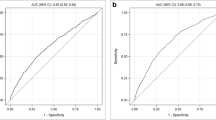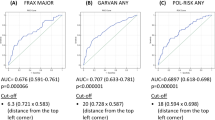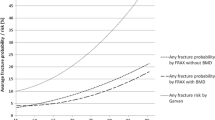Abstract
Summary
We have developed clinical nomograms for predicting 5-year and 10-year fracture risks for any elderly man or woman. The nomograms used age and information concerning fracture history, fall history, and BMD T-score or body weight.
Introduction
Although many fracture risk factors have been identified, the translation of these risk factors into a prognostic model that can be used in primary care setting has not been well realized. The present study sought to develop a nomogram that incorporates non-invasive risk factors to predict 5-year and 10-year absolute fracture risks for an individual man and woman.
Methods
The Dubbo Osteoporosis Epidemiology Study was designed as a community-based prospective study, with 1358 women and 858 men aged 60+ years as at 1989. Baseline measurements included femoral neck bone mineral density (FNBMD), prior fracture, a history of falls and body weight. Between 1989 and 2004, 426 women and 149 men had sustained a low-trauma fracture (not including morphometric vertebral fractures). Two prognostic models based on the Cox’s proportional hazards analysis were considered: model I included age, BMD, prior fracture and falls; and model II included age, weight, prior fracture and fall.
Results
Analysis of the area under the receiver operating characteristic curve (AUC) suggested that model I (AUC = 0.75 for both sexes) performed better than model II (AUC = 0.72 for women and 0.74 for men). Using the models’ estimates, we constructred various nomograms for individualizing the risk of fracture for men and women. If the 5-year risk of 10% or greater is considered “high risk”, then virtually all 80-year-old men with BMD T-scores <-1.0 or 80-year-old women with T-scores <-2.0 were predicted to be in the high risk group. A 60-year-old woman’s risk was considered high risk only if her BMD T-scores ≤-2.5 and with a prior fracture; however, no 60-year-old men would be in the high risk regardless of their BMD and risk profile.
Conclusion
These data suggest that the assessment of fracture risk for an individual cannot be based on BMD alone, since there are clearly various combinations of factors that could substantially elevate an individual’s risk of fracture. The nomograms presented here can be useful for individualizing the short- and intermediate-term risk of fracture and identifying high-risk individuals for intervention to reduce the burden of fracture in the general population.





Similar content being viewed by others
References
Cummings SR, Melton LJ (2002) Epidemiology and outcomes of osteoporotic fractures. Lancet 359:1761–1767
Raisz LG (2005) Pathogenesis of osteoporosis: concepts, conflicts, and prospects. J Clin Invest 115:3318–3325
Black DM, Steinbuch M, Palermo L, Dargent-Molina P, Lindsay R, Hoseyni MS, Johnell O (2001) An assessment tool for predicting fracture risk in postmenopausal women. Osteoporos Int 12:519–528
van Staa TP, Geusens P, Kanis JA, Leufkens HG, Gehlbach S, Cooper C (2006) A simple clinical score for estimating the long-term risk of fracture in post-menopausal women. QJM 99:673–682
Ettinger B, Hillier TA, Pressman A, Che M, Hanley DA (2005) Simple computer model for calculating and reporting 5-year osteoporotic fracture risk in postmenopausal women. J Womens Health (Larchmt) 14:159–171
Nguyen ND, Frost SA, Center JR, Eisman JA, Nguyen TV (2007) Development of a nomogram for individualizing hip fracture risk in men and women. Osteoporos Int 18:1109–1117
Wyatt JC, Altman DG (1995) Commentary: prognostic models: clinically useful or quickly forgotten? BMJ 311:1539–1541
Nguyen T, Sambrook P, Kelly P, Jones G, Lord S, Freund J, Eisman J (1993) Prediction of osteoporotic fractures by postural instability and bone density. BMJ 307:1111–1115
Marshall D, Johnell O, Wedel H (1996) Meta-analysis of how well measures of bone mineral density predict occurrence of osteoporotic fractures. BMJ 312:1254–1259
Johnell O, Kanis JA, Oden A, Johansson H, De Laet C, Delmas P, Eisman JA, Fujiwara S, Kroger H, Mellstrom D, Meunier PJ, Melton LJ 3rd, O, Neill T, Pols H, Reeve J, Silman A, Tenenhouse A (2005) Predictive value of BMD for hip and other fractures. J Bone Miner Res 20:1185–1194
Kanis JA, Johnell O, De Laet C, Johansson H, Oden A, Delmas P, Eisman J, Fujiwara S, Garnero P, Kroger H, McCloskey EV, Mellstrom D, Melton LJ, Pols H, Reeve J, Silman A, Tenenhouse A (2004) A meta-analysis of previous fracture and subsequent fracture risk. Bone 35:375–382
Nguyen ND, Pongchaiyakul C, Center JR, Eisman JA, Nguyen TV (2005) Identification of high-risk individuals for hip fracture: a 14-year prospective study. J Bone Miner Res 20:1921–1928
Jones G, Nguyen T, Sambrook PN, Kelly PJ, Gilbert C, Eisman JA (1994) Symptomatic fracture incidence in elderly men and women: the Dubbo Osteoporosis Epidemiology Study (DOES). Osteoporos Int 4:277–282
Simons LA, McCallum J, Simons J, Powell I, Ruys J, Heller R, Lerba C (1990) The Dubbo study: an Australian prospective community study of the health of elderly. Aust N Z J Med 20:783–789
Nguyen TV, Center JR, Sambrook PN, Eisman JA (2001) Risk factors for proximal humerus, forearm, and wrist fractures in elderly men and women: the Dubbo Osteoporosis Epidemiology Study. Am J Epidemiol 153:587–595
National Osteoporosis Society (1998) Guidance on the prevention and management of corticosteroid induced osteoporosis. National Osteoporosis Society, Camerton, Bath, UK
Angus RM, Sambrook PN, Pocock NA, Eisman JA (1989) A simple method for assessing calcium intake in Caucasian women. J Am Diet Assoc 89:209–214
Nguyen TV, Sambrook PN, Eisman JA (1997) Sources of variability in bone mineral density measurements: implications for study design and analysis of bone loss. J Bone Miner Res 12:124–135
Henry MJ, Pasco JA, Pocock NA, Nicholson GC, Kotowicz MA (2004) Reference ranges for bone densitometers adopted Australia-wide: Geelong osteoporosis study. Australas Radiol 48:473–475
Pocock NA, Sambrook PN, Nguyen T, Kelly P, Freund J, Eisman JA (1992) Assessment of spinal and femoral bone density by dual X-ray absorptiometry: comparison of lunar and hologic instruments. J Bone Miner Res 7:1081–1084
Hoeting JA (1999) Bayesian model averaging: a tutorial. Stat Sci 14:382–147
Raftery AE, Madigan D, Hoeting JA (1997) Bayesian model averaging dor linear regression models. J Am Stat A 92:179–191
Volinsky CT, Madigan D, Raftery AE, Kronmal RA (1997) Bayesian model averaging in proportional hazard models: assessing the risk of a stroke. Appl Statist 48:433–448
Raftery AE (1995) Bayesian model selection in social research. In: Marsden PV (ed) Sociological methodology. Blackwell, Cambridge, MA
Swets JA (1986) Form of empirical ROCs in discrimination and diagnostic tasks: implications for theory and measurement of performance. Psychol Bull 99:181–198
Swets JA (1986) Indices of discrimination or diagnostic accuracy: their ROCs and implied models. Psychol Bull 99:100–117
Swets JA (1988) Measuring the accuracy of diagnostic systems. Science 240:1285–1293
Hanley JA, McNeil BJ (1982) The meaning and use of the area under a receiver operating characteristic (ROC) curve. Radiology 143:29–36
Cox DR (1972) Regression models and life tables. J R Stat Soc (B) 34:187–220
Cox DR, Snell EJ (1989) Analysis of binary data. Chapman and Hall, London, U.K
Harrell FE Jr, Lee KL, Mark DB (1996) Multivariable prognostic models: issues in developing models, evaluating assumptions and adequacy, and measuring and reducing errors. Stat Med 15:361–387
R Development Core Team (2007) R: a language and environment for statistical computing. In. R Foundation for Statistical Computing, Vienna, Austria
Harrell FE Jr, Margolis PA, Gove S, Mason KE, Mulholland EK, Lehmann D, Muhe L, Gatchalian S, Eichenwald HF (1998) Development of a clinical prediction model for an ordinal outcome: the World Health Organization Multicentre Study of Clinical Signs and Etiological agents of Pneumonia, Sepsis and Meningitis in Young Infants. WHO/ARI young infant multicentre study group. Stat Med 17:909–944
Ensrud KE, Lipschutz RC, Cauley JA, Seeley D, Nevitt MC, Scott J, Orwoll ES, Genant HK, Cummings SR (1997) Body size and hip fracture risk in older women: a prospective study. Study of osteoporotic fractures research group. Am J Med 103:274–280
Henry MJ, Pasco JA, Sanders KM, Nicholson GC, Kotowicz MA (2006) Fracture Risk (FRISK) Score: Geelong osteoporosis study. Radiology 241:190–196
Cummings SR (2006) A 55-year-old woman with osteopenia. JAMA 296:2601–2610
Sambrook PN, Eisman JA (2000) Osteoporosis prevention and treatment. Med J Aust 172:226–229
Dargent-Molina P, Douchin MN, Cormier C, Meunier PJ, Breart G (2002) Use of clinical risk factors in elderly women with low bone mineral density to identify women at higher risk of hip fracture: The EPIDOS prospective study. Osteoporos Int 13:593–599
Cranney A, Guyatt G, Griffith L, Wells G, Tugwell P, Rosen C (2002) Meta-analyses of therapies for postmenopausal osteoporosis. IX: summary of meta-analyses of therapies for postmenopausal osteoporosis. Endocr Rev 23:570–578
Nguyen ND, Eisman JA, Nguyen TV (2006) Anti-hip fracture efficacy of bisphosphonates: a bayesian analysis of clinical trials. J Bone Miner Res 21:340–349
Vestergaard P, Jorgensen NR, Mosekilde L, Schwarz P (2007) Effects of parathyroid hormone alone or in combination with antiresorptive therapy on bone mineral density and fracture risk-a meta-analysis. Osteoporos Int 18:45–57
Kanis JA, Borgstrom F, De Laet C, Johansson H, Johnell O, Jonsson B, Oden A, Zethraeus N, Pfleger B, Khaltaev N (2005) Assessment of fracture risk. Osteoporos Int 16:581–589
Kanis JA, Johansson H, Oden A, Johnell O, De Laet C, Eisman JA, McCloskey EV, Mellstrom D, Melton LJ 3rd, Pols HA, Reeve J, Silman AJ, Tenenhouse A (2004) A family history of fracture and fracture risk: a meta-analysis. Bone 35:1029–1037
Kanis JA, Johansson H, Oden A, Johnell O, de Laet C, Melton IL, Tenenhouse A, Reeve J, Silman AJ, Pols HA, Eisman JA, McCloskey EV, Mellstrom D (2004) A meta-analysis of prior corticosteroid use and fracture risk. J Bone Miner Res 19:893–899
Pongchaiyakul C, Nguyen ND, Jones G, Center JR, Eisman JA, Nguyen TV (2005) Asymptomatic vertebral deformity as a major risk factor for subsequent fractures and mortality: a long-term prospective study. J Bone Miner Res 20:1349–1355
Harrel FE (2001) Regression modeling strategies with applications to linear models, logistic regression, and survival analysis. Springer, New York, NY
Royston P, Altman DG, Sauerbrei W (2006) Dichotomizing continuous predictors in multiple regression: a bad idea. Stat Med 25:127–141
Bianco FJ Jr (2006) Nomograms and medicine. Eur Urol 50:884–886
Kattan MW (2003) Nomograms are superior to staging and risk grouping systems for identifying high-risk patients: preoperative application in prostate cancer. Curr Opin Urol 13:111–116
Wong SL, Kattan MW, McMasters KM, Coit DG (2005) A nomogram that predicts the presence of sentinel node metastasis in melanoma with better discrimination than the American Joint Committee on Cancer staging system. Ann Surg Oncol 12:282–288
Ross PL, Gerigk C, Gonen M, Yossepowitch O, Cagiannos I, Sogani PC, Scardino PT, Kattan MW (2002) Comparisons of nomograms and urologists’ predictions in prostate cancer. Semin Urol Oncol 20:82–88
Hosmer DW, Lemeshow S (1999) Assessing the fit of the model. In Apllied logistic regression. Wiley J, New York, pp 135–175
Kattan M (2002) Statistical prediction models, artificial neural networks, and the sophism “I am a patient, not a statistic”. J Clin Oncol 20:885–887
Ensrud KE, Black DM, Palermo L, Bauer DC, Barrett-Connor E, Quandt SA, Thompson DE, Karpf DB (1997) Treatment with alendronate prevents fractures in women at highest risk: results from the Fracture Intervention Trial. Arch Intern Med 157:2617–2624
Borgstrom F, Johnell O, Kanis JA, Jonsson B, Rehnberg C (2006) At what hip fracture risk is it cost-effective to treat? International intervention thresholds for the treatment of osteoporosis. Osteoporos Int 17:1459–1471
Acknowledgments
We gratefully acknowledge the assistance of Janet Watters, Donna Reeves, Shaye Field and Jodie Ratleg for the interview, data collection and measurement bone mineral density. We also appreciate the invaluable help of the staff of Dubbo Base Hospital. We thank David Hayes and the IT group of the Garvan Institute of Medical Research for the management of the database.
Conflict of interest statement
Dr. John Eisman serves as a consultant and receives corporate appointment from Amgen, deCode, Eli Lilly and Company, GE-Lunar, Merck Sharp & Dohme Ltd., Novartis, Organon, Roche-GSK, sanofi-aventis and Servier. All other authors have no conflict of interest.
Author information
Authors and Affiliations
Corresponding author
Additional information
Source of financial support: This works has been supported by the National Health and Medical Research Council of Australia, and untied educational grants from GE-Lunar, Merck Australia, Eli Lilly International and sanofi-aventis Australia.
Rights and permissions
About this article
Cite this article
Nguyen, N.D., Frost, S.A., Center, J.R. et al. Development of prognostic nomograms for individualizing 5-year and 10-year fracture risks. Osteoporos Int 19, 1431–1444 (2008). https://doi.org/10.1007/s00198-008-0588-0
Received:
Accepted:
Published:
Issue Date:
DOI: https://doi.org/10.1007/s00198-008-0588-0




